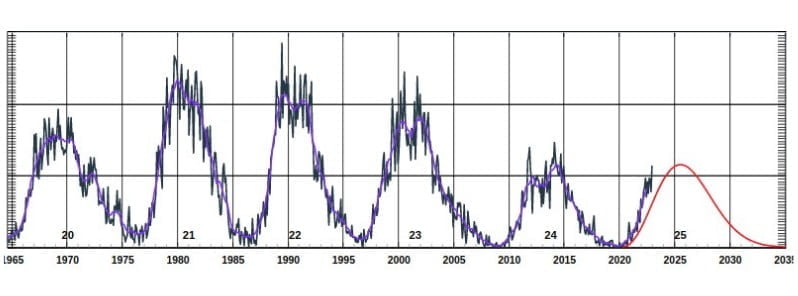Unlocking solar activity: Correlation between the Sun’s Hale magnetic cycle and Extended Solar Cycle

New research from the Wilcox Solar Observatory (WSO) has found evidence for the correspondence of the “Extended Solar Cycle” (ESC) to the Sun’s Hale magnetic cycle. The research emphasizes the intrinsic power of synoptic observations, particularly at a time when it is becoming increasingly difficult to sustain such efforts.
- This short manuscript presents the correspondence of the ESC, the surface toroidal magnetic field evolution, and the evolution of the Hale Cycle
- As Sunspot Cycle 25 begins, interest in observationally mapping the Hale and Extended cycles could not be higher given potential predictive capability that synoptic scale observations can provide
The Hale magnetic cycle, also known as the bipolar magnetic cycle, is named after George Ellery Hale, an American astronomer who first observed the cyclic nature of sunspots in the early 20th century. The cycle is characterized by the regular reversal of the Sun’s large-scale magnetic field, which occurs every 22 years. This reversal is accompanied by changes in the number and size of sunspots, as well as other manifestations of solar activity such as flares and coronal mass ejections.
The Extended Solar Cycle (ESC) is a concept that was first proposed in the early 2000s to describe a long-term modulation of solar activity that occurs on top of the 11-year sunspot cycle. The ESC is characterized by the presence of “activity bands” that move from high to low latitudes over the course of several decades, and which can affect the amplitude and progression of sunspot cycles. The ESC is thought to be related to the Sun’s internal magnetic field, but the exact mechanism by which it operates is not fully understood.
While recent research has highlighted the persistence of the ESC and its connection to the fundamental Hale Cycle, it was done through a host of proxies resulting from image analysis of the solar photosphere, chromosphere and corona.
Now, through meticulous daily observation of the Sun’s large-scale magnetic field, a team of researchers reporting in Frontiers in Astronomy and Space Sciences have cataloged two magnetic (Hale) cycles of solar activity, yielding four (∼11-year long) sunspot cycles (numbers 21 through 24).
Their observations have captured two complete 22-year Hale cycles and have permitted a mapping of the Sun’s photospheric toroidal magnetic field component over that time frame.
The key features of the WSO observations compare directly to the data-inspired schematic of the ESC, which illustrates how the activity bands of the ESC can shape the latitudinal progression of sunspot cycles and their amplitude.1
The study findings indicate that the ESC and the Hale magnetic cycle are physically one and the same, and therefore indistinguishable.
These low spatial resolution ground-based observations are corroborated by higher resolution space-based magnetographic observations from SOHO and SDO, who identify zero-crossing events associated with Hale Cycle terminators.
The study shows that the ESC has predictive capability, providing strong indicators of the current progression and potential evolution of upcoming solar activity at the decadal scale, beyond those amenable through the analysis of sunspots.
The research emphasizes the intrinsic power of synoptic observations, particularly at a time when it is becoming increasingly difficult to sustain such efforts.
The paper was published on October 22, 2022, in the scientific journal “Frontiers in Astronomy and Space Sciences” by Scott W. McIntosh of the National Center for Atmospheric Research (NCAR), Philip H. Scherrer from Stanford University’s Hansen Experimental Physics Laboratory, Leif Svalgaard from Goddard Planetary Heliophysics Institute, University of Maryland–Baltimore County, and Robert J. Leamon from NASA Goddard Space Flight Center.
References:
Uniting the Sun’s Hale magnetic cycle and “extended solar cycle” paradigms – Frontiers in Astronomy and Space Sciences – Scott W. McIntosh et al. – October 2022 – https://doi.org/10.3389/fspas.2022.923049 – OPEN ACCESS
Featured image credit: NOAA/SWPC, The Watchers

Commenting rules and guidelines
We value the thoughts and opinions of our readers and welcome healthy discussions on our website. In order to maintain a respectful and positive community, we ask that all commenters follow these rules.